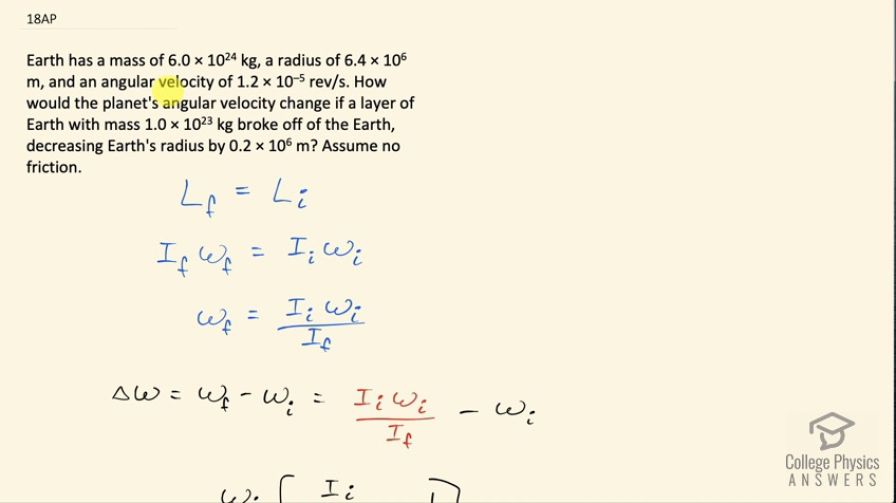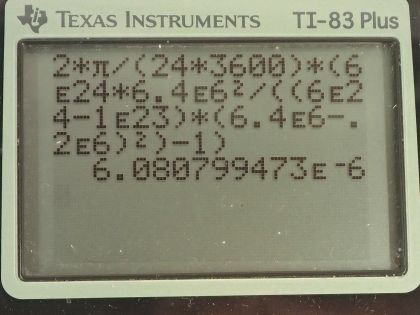Question
Earth has a mass of , a radius of , and an angular velocity of . How would the planet's angular velocity change if a layer of Earth with mass broke off of the Earth, decreasing Earth's radius by ? Assume no friction.
Final Answer
Solution video
OpenStax College Physics for AP® Courses, Chapter 10, Problem 18 (Test Prep for AP® Courses)

vote with a rating of
votes with an average rating of
.
Calculator Screenshots
Video Transcript
This is College Physics Answers with Shaun Dychko. Earth has a mass of 6 times 10 to the 24 kilograms and a radius of 6.4 times 10 to the 6 meters and an angular velocity of 1.2 times 10 to the minus 5 revolutions per second, how would the planet's angular velocity change if the layer of the Earth with this mass broke off and the Earth's radius decreased by this much? So we are talking about the Earth's rotational angular momentum not the angular momentum around the Sun. So we know that the angular momentum will be conserved so the final angular momentum will equal the initial angular momentum and that is the final moment of inertia times the final angular velocity will equal the initial angular velocity times the initial moment of inertia and we can solve for ω f by dividing both sides by the final moment of inertia and our job is to figure out by how much does the angular velocity change and so this Δω is gonna be the final angular velocity minus the initial angular velocity. So we can substitute this ratio of moments of inertia multiplied by initial angular velocity in place of ω f and then subtract from that ω i ω i factors out and we have the ratio of moments of inertia minus 1 and then the moment of inertia for a sphere we can look up in this figure [10.12] and it's gonna be 2 times its mass times its radius squared over 5 and so we have the initial moment of inertia is 2 times the initial mass times the initial radius squared over 5 and then the final moment of inertia is 2 times the final mass times the final radius squared over 5. And we are gonna divide these so taking this top fraction which is 2m ir i squared over 5 and dividing it by this fraction which is here, I am going to instead multiply by its reciprocal and that makes our work a little bit cleaner; instead of having a fraction divided by a fraction, we are gonna take a fraction and multiply it by the reciprocal of the denominator the 5's cancel, the 2's cancel and we are left with this expression here and then we can plug in numbers. So the initial angular velocity— I know it's given to us, it's 1.2 times 10 to the minus 5 revolutions per second but I'm going to get a more precise number and I'm plugging in 2π radians, which is 1 revolution in 24 hours but converted into seconds by multiplying by 3600 seconds per hour so that's the initial angular velocity. We multiply it by the initial mass times the initial Earth radius squared and divide by the new mass, which is 6.0 times 10 to the 24 minus 1.00 times 10 to the 23 kilograms and then multiply that by the new radius, which is the original radius— 6.4 times 10 to the 6 meters—minus the amount by which it's reduced, which is 0.2 times 10 to the 6 meters and we square that result minus 1 and this all works out to 6.1 times 10 to the minus 6 radius per second. So that's the amount by which the angular velocity of the Earth would change.
